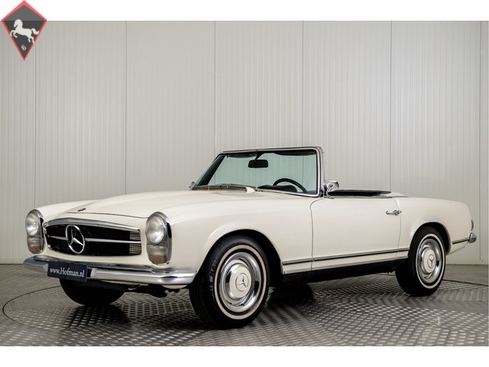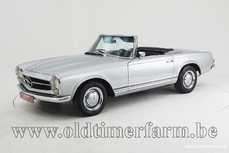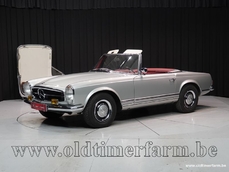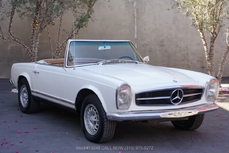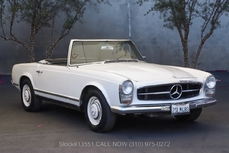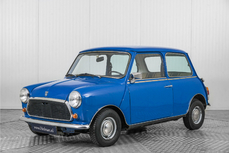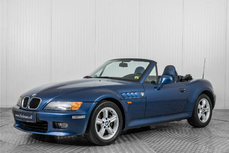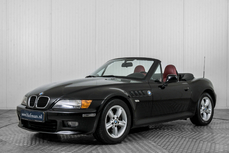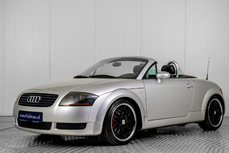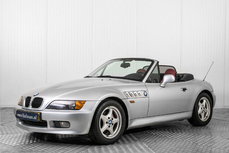Mercedes-Benz 250SL w113 1967
General description :
Schitterende en ook zeer originele Mercedes-Benz 230 SL van bouwjaar 1967. Een mooie auto om te zien in de keurige Crème kleur in combinatie met prachtig chroomwerk en de white-wall banden. De carrosserie verkeert in een zeer gave conditie en heeft strakke passingen. Het interieur komt eveneens in een aantrekkelijke staat, het geheel is met zorg behandelt en compleet. In het stijlvolle dashboard zijn de authentieke VDO instrumenten aanwezig en intact. De bekleding van de stoelen, vloer en deurpanelen werd enkele jaren geleden al eens vernieuwd. Onder de motorkap ligt de sterke 2.3 6-in-lijn motor goed voor bijna 150 paardenkrachten. De combinatie tussen de prettige motor en de automatische transmissie maken deze Benz tot een heerlijke rijders auto geschikt voor consequent gebruik en langere afstanden. Het grootste deel van zijn leeftijd spendeerde de auto in de Amerikaanse staat Californië, het gunstige klimaat daar heeft er voor gezorgd dat chassis en carrosserie droog en gaaf bewaard zijn gebleven. De onderzijde van het voertuig is uiterst solide en origineel! In 2014 kwam de SL naar Europa en is sindsdien in bezit geweest van 1 Duitse eigenaar. In 2017 werd de motor gereviseerd evenals de cilinderkop. In 2019 werd er eveneens zeer groot technisch onderhoud uitgevoerd door een bekende Nederlandse Mercedes specialist. Diverse rekeningen en foto's zijn ter inzage beschikbaar. Op het moment is de auto voorzien van Duitse registratiepapieren maar uiteraard kunnen wij zorgen voor een Nederlands kenteken. Als mooie extra is de originele hardtop aanwezig. DEUTSCH: Mercedes 230 SL Baujahr 1967 in sehr originalem und gutem Zustand! Neu in den USA Kalifornien geliefert und seit 2014 in Europa. Der Auto war im Besitz von 1 Deutschen Liebhaber und hat Deutsche Zulassungspapiere. Motor und Zylinderkopf wurden 2017 überholt. Im Jahr 2019 wurden umfangreiche technische Wartungsarbeiten durchgeführt. Verschiedene Rechnungen sind vorhanden. Das Auto wird mit einem originalen Hardtop geliefert. Bedrijfsinformatie: Prijswijzigingen, druk- en zetfouten voorbehouden. Altijd ruim 500 auto's op voorraad, check de actuele voorraad via http://www.hofman.nl. Volg ons ook op facebook.com/HofmanLeek. Bel ons voor de mogelijkheden voor inkoop, verkoop, consignatieverkoop en stalling. * Veilig online kopen @ hofman.nl * Levering aan huis mogelijk * Inruil mogelijk. Al onze autos staan met een zeer uitgebreide fotoreportage (60-100 fotos) online op http://www.hofman.nl
Getint glas, Half lederen bekleding, Hardtop, Hout accenten, Massaschakelaar, Toerenteller, White wall banden, Windscherm
1967 Mercedes-Benz 250SL w113 is listed for sale on ClassicDigest in Netherlands by Hofman Leek for €69900.
Car Facts
Car type : Car Make : Mercedes-Benz Model : 250SL w113 Engine size : 2.3 Model Year : 1967 Sub type : Convertible Location : Netherlands Vehicle Registration : Undefined
69900 €
People who viewed this Mercedes-Benz 250SL w113 also viewed similar Mercedes-Benz listed at ClassicDigest
Other cars listed for sale by this dealer
About Mercedes-Benz
In the annals of automotive history, the journey of Mercedes-Benz is a tale that unfolds with the ingenuity of its founding pioneers. In the year 1886, Karl Benz crafted the Benz Patent Motorwagen, a creation that would go down in history as the world's inaugural automobile. Unbeknownst to him, this moment marked the genesis of what would evolve into the most illustrious premium car manufacturer globally. The financial underpinning of this pioneering venture, interestingly, was provided by Karl Benz's wife, Bertha Benz, demonstrating a remarkable partnership that would set the tone for Mercedes-Benz's legacy.A parallel narrative emerged not far away, as Daimler-Motoren-Gesellschaft, founded by Gottlieb Daimler and Wilhelm Maybach, entered the scene. In 1901, they unveiled their automobile under the now-famous moniker "Mercedes," meaning "godsend" in Spanish. This name was bestowed upon the car at the behest of Emil Jellinek's daughter, the distributor for Daimler-Motoren-Gesellschaft. The wheels of innovation were set in motion.
Fast forward to 1926, a pivotal year that witnessed the merger of Daimler with Benz & Cie., culminating in the birth of Daimler-Benz. The amalgamation saw the adoption of "Mercedes-Benz" as the distinguished trademark for their automobiles, fusing the legacies of two visionary entities into one.
Contrary to perceptions of conservatism, the trajectory of Daimler-Benz unfolds as a chronicle of industry firsts. From the introduction of the honeycomb radiator to the float carburetor, and the pioneering implementation of four-wheel brakes in 1924, Daimler-Benz consistently pushed the boundaries of automotive innovation. The diesel-powered Mercedes-Benz 260 D in 1936 marked the inception of diesel engines in passenger cars. The iconic Mercedes-Benz 300SL Gullwing made history as the first car with direct fuel injection, albeit the Gutbrod's tiny 2-stroke engine can claim precedence.
Safety innovations became a hallmark, with Béla Barényi's patented safety cell design in the "Ponton"-models in 1951, featuring front and rear crumple zones. The W116 450SEL 6.9 saw the introduction of the Anti-Lock Brake system (ABS), another pioneering safety feature. From the first production airbags and beyond, the legacy of "firsts" continued to be etched into the fabric of Daimler-Benz.
Over its centennial journey, Mercedes-Benz has not merely produced cars but has sculpted automotive icons. The SSKL, 710 SSK Trossi Roadster, 770K Grosser, 540K Spezial Roadster, 300SL Gullwing, w100 600 Pullman, w111 280SE 3.5 Flachkühler, w113 230SL Pagoda, w109 300 SEL 6.3, and w201 2.3-16 Cosworth stand testament to the brand's commitment to engineering excellence.
The roaring Silver Arrows, or "Silberpfeile," including the W 25, W 125, W154, W165, and W196, created a legacy of dominance on the racetrack. These machines were not merely cars; they were expressions of precision, speed, and an indomitable spirit that left their competitors in the dust.
As Mercedes-Benz marches into the future, it does so not just as an automaker but as a custodian of a legacy, a torchbearer of innovation, and a beacon of automotive excellence. The road ahead is sure to witness the continued fusion of cutting-edge technology, timeless design, and an unwavering commitment to setting new standards in the world of automobiles.
One luminary figure who left an indelible mark was Béla Barényi, often heralded as the "father of passive safety" for his pioneering work in safety engineering. His patented safety cell design, featuring front and rear crumple zones, became a hallmark of Mercedes-Benz's commitment to occupant safety, setting new standards that reverberated throughout the automotive world.
Moving through the chronicles, the collaborative genius of Wilhelm Maybach, alongside Gottlieb Daimler, laid the foundation for Daimler-Motoren-Gesellschaft. Their innovations not only birthed the first Mercedes but established a culture of relentless pursuit of technological excellence that remains integral to Mercedes-Benz's DNA.
In the post-merger era of 1926, Ferdinand Porsche emerged as a prominent figure within Mercedes-Benz. His work on the Mercedes-Benz S-Type, a supercharged race car, garnered acclaim and set the stage for a legacy that extended far beyond the marque. Porsche's impact would later extend to his eponymous company, but his influence at Mercedes-Benz during those formative years was pivotal.
As the 20th century progressed, the legendary Rudolf Uhlenhaut emerged as a key figure. Uhlenhaut, an accomplished engineer and the driving force behind the iconic Silver Arrows, played a crucial role in Mercedes-Benz's dominance in motorsports. His engineering prowess and attention to detail were instrumental in creating some of the most formidable racing cars of the era.
In the latter half of the century, figures like Bruno Sacco, the head of design at Mercedes-Benz from 1975 to 1999, left an indelible imprint on the brand's aesthetic identity. Sacco's design philosophy, characterized by clean lines and timeless elegance, shaped iconic models like the W126 S-Class and the W201 190E, solidifying Mercedes-Benz's reputation for luxury and sophistication.
The narrative would be incomplete without acknowledging the contributions of engineers like Hans Scherenberg, whose leadership in the 1970s ushered in a new era of technological innovation at Mercedes-Benz. Scherenberg's tenure saw the development of groundbreaking technologies, including the Anti-Lock Brake system (ABS) and the introduction of airbags in production cars.
